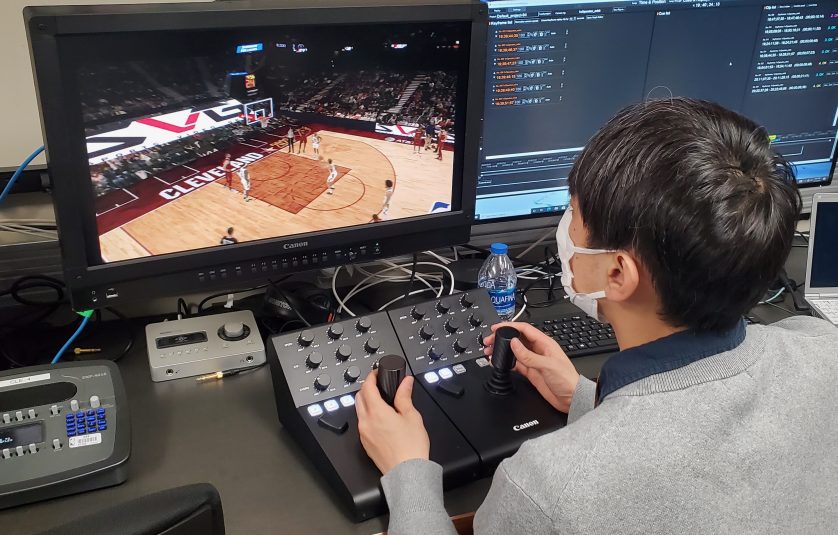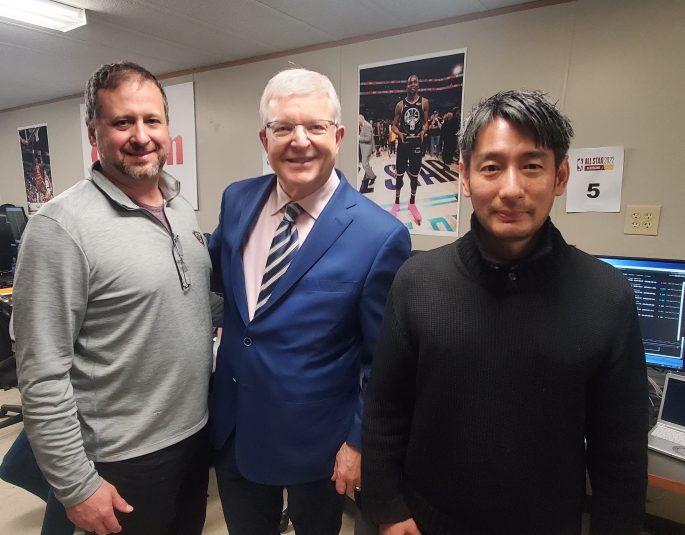Live From NBA All-Star: Canon Free Viewpoint To Make U.S. Broadcast Debut
Improved system takes volumetric video to new level for live sports production and more
Story Highlights
The Canon Free Viewpoint volumetric capture system will take its next step tonight during the NBA All-Star Game. More than 100 Canon Cinema EOS-based cameras and lenses inside Cleveland’s Rocket Mortgage FieldHouse will be used to give replays a whole new look.

The Canon Free Viewpoint system will allow an operator to fly a virtual camera through volumetric video capture of tonight’s NBA All-Star Game.
“It has been a long time coming,” says Steve Hellmuth, executive vice president of media operations and technology, NBA, noting that discussions with Canon began at NAB in 2019. “But Canon was great, soliciting our advice and keeping us updated on the progress. We remained in touch, and Canon decided to grace us with two systems.” One has been installed at the Barclays Center in Brooklyn, the other in Cleveland; both will remain in place through the end of the season.

From left: Brent Valenti of Bally Sports Ohio, Steve Hellmuth of the NBA, and Tsuyoshi Wakazono of Canon at the NBA All-Star Game
“We decided to install it [at Rocket Mortgage Fieldhouse] because of the All-Star Game and also because the Cavaliers are a great outfit for introducing new technology,” he says. “They gave us the rack space inside the building and also allowed for the installation of the cameras around the perimeter of the arena.”
Tonight’s use will emphasize new types of replays: a virtual camera can swoop around and between players and virtually go anywhere in the building.
“This will allow us to fly in the arena,” notes Hellmuth. “It will be like having six drones in the building without any limitations and any liability.” He believes all leagues should be looking at volumetric capture because it offers multiple benefits well beyond cool replays.
“At the end of the day,” he adds, “you get player tracking and player positioning, and, with AI, you can generate statistics and can also create metrics that don’t exist today. For example, right now, deciding whether a player defended a shot is a manual process, but, with this, you can write into the AI [that, if the hand is here relative to the ball,] it’s a defended shot.”
The cameras in the system capture the video information, which is processed on proprietary Canon image-processing boxes behind each camera and turned into data. The data from all the cameras is then sent to a server system that creates a point-cloud 3D model of the players and other objects on the court. Images are built using voxels, which are units of graphic information that define a point in three-dimensional space (basically, the 3D equivalent of a pixel) combined with RGB values. An operator with a joystick akin to a cabled camera system flies the virtual camera within the virtual environment and builds the clips in a process similar to rendering an animation.
The system made its public debut at the 2019 Rugby World Cup, where 125 cameras were used, but three years of innovation will result in a more robust production experience.
During the Rugby World Cup, says Tsuyoshi Wakazono, manager, Image Solutions Business Operations, Canon SV Business Planning Department, rendering the replay took about 15 minutes. “Now we are integrated into the live broadcast so we can quickly turn around a clip in about 10 seconds and also keep streaming so other highlights can be created.”
The applications for volumetric capture are numerous: besides the broadcast and social-media applications, uses range from videogames to VR to officiating, training, and coaching. “It creates a perfect VR environment that is free of convergence issues and will allow fans to take seats they wish to take in a VR environment, so it holds tremendous promise,” says Hellmuth. “All of our videogaming partners are visiting us to create the ideal data set for videogames because they can get a perfect model of the players.”
He notes that the benefits extend to the officials, teams, coaches, and players. Officials, for example, could look at plays from any angle and zoom in from any angle, solving one of the big problems in relying on camera angles framed to include multiple players. The virtual environment also will not have the stanchions supporting the hoop and backboard, allowing officials a better view of plays under the basket.
“We can now put the virtual camera right behind the basket and looking straight out at the court because the stanchion is gone,” adds Hellmuth.
The system does require a lot of storage, about 60 TB per game. But continued improvements in storage, the use of edge computing, and even 5G could make it easier to move the vast amounts of data around.
“The amazing thing is, Canon has figured out how to do all of that in only three seconds,” says Hellmuth. “It’s a unique collaboration because Canon understands lenses, imaging, and how to translate that into digital.”
The efforts tonight will be part of the Turner Sports production as well as the world feed, the NBA’s social-media channels, and more. “It’s getting a global reception,” he adds, “and the fact that I’ve been on the phone with China for a few nights this week shows the interest.”
Brent Valenti, senior producer, Bally Sports Ohio, is looking forward to putting the system through its paces for the rest of the season. “We’ll be playing more with it, and it will help out with our analysis.”
